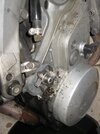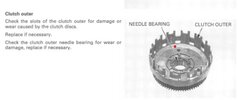Scooter
This space for rent...
Thought that I'd add another data point to the article. One of the reasons I always liked to give Curt a hand whenever he asked was that I knew that sooner or later, I'd likely need to do the same thing to my bike. It's always easier to hone ones skills on other peoples bikes. 
FYI: Original thread for this article can be found here. There is more information there that some people might find useful.
Well, 4 years later and with 148k miles on the clock I needed to remove the front crankcase cover in order to rebuild the water pump assembly. With this done I realized that it would be foolish not to take apart the clutch to see how much wear and tear I've accumulated on it and see if any parts were in need of replacement. To date, I have not experienced any drivability issues with it and I didn't want to needlessly order a new clutch kit if I didn't need to. Here is what I found:
Clutch spring measurements in mm. According to the 2003 Service Manual, Standard spring free length is 55.0mm with the service limit at 54.0mm.
Spring 1 54.06
Spring 2 54.02
Spring 3 54.05
Spring 4 54.25
Spring 5 54.03
Spring 6 54.01
I see that all but one of the springs are right at the service limit, so they will be replaced.
As for the clutch friction plates, in order from front to rear:
Clutch Plate 1 3.88
Clutch Plate 2 3.75
Clutch Plate 3 3.76
Clutch Plate 4 3.78
Clutch Plate 5 3.78
Clutch Plate 6 3.77
Clutch Plate 7 3.75
Clutch Plate B 3.83
Clutch friction plate ?Standard? thickness according to the service manual is 3.72-3.88 mm with a service limit of 3.50mm. Seems like I?ve got some significant life left in the plates. No discoloration on any of them and they are all flat. Replacement cost of the plates would run about $150 not including the springs which I'm already ordering. Don?t see the need right now to order new plates. Just one of the advantages of doing your own work.
I remember how much sand and grit we found in Curt's bike once we removed the covers. I think he was trying to create a new nature preserve. Here's a picture of what I had stuck in the secret passages:

Not too bad. I noticed that my crankcase cover bolts seemed much easier to remove than his were. I know that he bought that bike used, perhaps the previous owner had the cover off previously and used some Locktite on them. Toughest part of this job will be removing the paper gasket from the crankcase. From what I've seen so far, the gasket on my bike looks rather brittle so maybe it will peel off easier.
If anyone has a new set of Honda OEM clutch friction plates on hand can you measure the thickness of a couple of them for me? This will give me a better feel for how much life I've got left in my plates...
FYI: Original thread for this article can be found here. There is more information there that some people might find useful.
Well, 4 years later and with 148k miles on the clock I needed to remove the front crankcase cover in order to rebuild the water pump assembly. With this done I realized that it would be foolish not to take apart the clutch to see how much wear and tear I've accumulated on it and see if any parts were in need of replacement. To date, I have not experienced any drivability issues with it and I didn't want to needlessly order a new clutch kit if I didn't need to. Here is what I found:
Clutch spring measurements in mm. According to the 2003 Service Manual, Standard spring free length is 55.0mm with the service limit at 54.0mm.
Spring 1 54.06
Spring 2 54.02
Spring 3 54.05
Spring 4 54.25
Spring 5 54.03
Spring 6 54.01
I see that all but one of the springs are right at the service limit, so they will be replaced.
As for the clutch friction plates, in order from front to rear:
Clutch Plate 1 3.88
Clutch Plate 2 3.75
Clutch Plate 3 3.76
Clutch Plate 4 3.78
Clutch Plate 5 3.78
Clutch Plate 6 3.77
Clutch Plate 7 3.75
Clutch Plate B 3.83
Clutch friction plate ?Standard? thickness according to the service manual is 3.72-3.88 mm with a service limit of 3.50mm. Seems like I?ve got some significant life left in the plates. No discoloration on any of them and they are all flat. Replacement cost of the plates would run about $150 not including the springs which I'm already ordering. Don?t see the need right now to order new plates. Just one of the advantages of doing your own work.
I remember how much sand and grit we found in Curt's bike once we removed the covers. I think he was trying to create a new nature preserve. Here's a picture of what I had stuck in the secret passages:

Not too bad. I noticed that my crankcase cover bolts seemed much easier to remove than his were. I know that he bought that bike used, perhaps the previous owner had the cover off previously and used some Locktite on them. Toughest part of this job will be removing the paper gasket from the crankcase. From what I've seen so far, the gasket on my bike looks rather brittle so maybe it will peel off easier.
If anyone has a new set of Honda OEM clutch friction plates on hand can you measure the thickness of a couple of them for me? This will give me a better feel for how much life I've got left in my plates...



